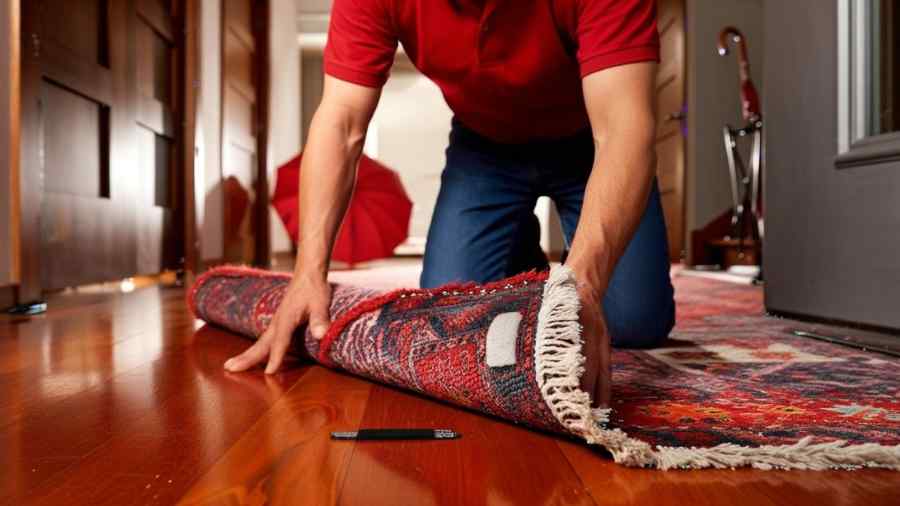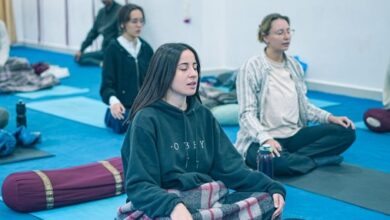How Do You Stop a Rug Moving on a Carpet?

Rugs add comfort, color, and personality to any home, especially when layered over carpets for extra warmth and style. But if you’ve ever had a rug slip, bunch, or wrinkle on carpeted flooring, you know how frustrating and even dangerous it can be. A shifting rug not only looks messy but also poses a tripping hazard and can cause premature wear on both the rug and the carpet beneath it.
Understanding how to stop a rug from moving on a carpet will help you keep your floors looking neat, safe, and beautiful. Whether you use rug pads, grippers, or simple household hacks, there’s a solution that fits every budget. And if you’re looking to enhance the longevity and cleanliness of your rugs and carpets, combining these methods with regular professional maintenance, such as trusted carpet cleaning services Brisbane, ensures both your rugs and carpets stay in top shape for years.
Why Do Rugs Move on Carpets?
Before jumping into solutions, it’s important to understand why rugs tend to slide or wrinkle when placed over carpet.
- Lack of Grip:
Carpets are made of soft fibers that reduce friction, causing rugs placed on top to move easily. - Pile Direction:
When the carpet pile runs in a different direction than the rug pile, the rug may “creep” as you walk over it. - Foot Traffic:
Regular walking, vacuuming, or movement of furniture can shift rugs gradually, especially in high-traffic areas. - Improper Rug Size:
Small or lightweight rugs are more prone to bunching compared to heavier or larger ones. - Underlay Issues:
Without a proper non-slip base, rugs are likely to move no matter how carefully they’re positioned.
The Dangers of a Moving Rug
A shifting rug may seem like a minor nuisance, but it can lead to several problems:
- Tripping Hazard: A sliding or wrinkled rug increases the risk of slips and falls.
- Carpet Damage: Constant friction between rug and carpet fibers can cause premature wear.
- Uneven Appearance: A rug that won’t stay in place ruins the overall look of a room.
- Furniture Movement: The rug’s motion can also cause chairs, tables, and decor to shift slightly over time.
Keeping rugs stable is not just a matter of aesthetics, it’s also about maintaining safety and protecting your flooring investment.
10 Effective Ways to Stop a Rug from Moving on a Carpet
There are several tried-and-tested solutions to keep your rug in place, from simple DIY methods to professional products designed specifically for this problem.
1. Use a Non-Slip Rug Pad
A non-slip rug pad is one of the most effective and affordable ways to prevent rugs from sliding on carpets. These pads are placed between the carpet and rug to add friction and grip.
- Choose a rug-to-carpet pad designed specifically for layered floors.
- Trim the pad to be slightly smaller than your rug to ensure it remains hidden.
- Place it flat under your rug and smooth out any wrinkles.
High-quality pads not only stop movement but also add cushioning, making your rug feel softer underfoot.
2. Apply Rug Grippers or Rug Tape
Rug grippers and double-sided rug tape work by adhering the rug’s underside to the carpet fibers below.
- Use carpet-specific rug tape to avoid damaging your carpet when removing it later.
- Stick the tape along the edges and corners of your rug for maximum hold.
- Press firmly to ensure strong adhesion.
If you have pets or kids running around, this method offers excellent stability. However, avoid low-quality tape that leaves sticky residue behind.
3. Try Silicone Caulk or Hot Glue
For a DIY approach, apply silicone caulk or hot glue to the underside of your rug.
- Draw small zigzag or dotted lines along the back of the rug.
- Let the adhesive dry until tacky before placing it on the carpet.
This creates a grippy texture that helps the rug stick in place while remaining removable later.
4. Use Hook-and-Loop Fasteners (Velcro Strips)
Hook-and-loop fasteners are a clever and reusable option.
- Attach one side of the Velcro to the rug’s underside and the other to the carpet beneath.
- Press them together firmly.
This method provides strong anchoring while allowing you to lift or reposition the rug easily when needed.
5. Anchor the Rug with Furniture
If your rug sits beneath a table, sofa, or bed, use the furniture’s weight to your advantage.
Place part of the rug under the furniture legs to hold it in place naturally.
For decorative or small rugs that can’t be anchored with heavy furniture, combine this trick with rug pads or grippers for added stability.
6. Use a Rug Underlay Mat
Rug underlay mats work similarly to non-slip pads but are typically made of natural rubber or felt.
They grip both surfaces effectively and protect your carpet from indentations or friction.
- Choose a dual-surface underlay suitable for carpeted floors.
- Avoid PVC-based underlays, as they can sometimes discolor carpet fibers over time.
7. Opt for Heavier Rugs
Lightweight rugs, such as thin cotton or synthetic options, are more likely to slide.
Consider replacing them with heavier, denser rugs that naturally stay in place better.
If you love the design of a lighter rug, you can weigh it down with furniture or combine it with an underlay for better grip.
8. Install Carpet Anchors or Clips
Carpet anchors are small, discreet clips that attach to both the rug and carpet, locking them together.
They’re particularly useful for rugs in hallways or staircases where frequent movement occurs.
Simply clip the anchor along the rug edges and press it into the carpet for a firm hold.
9. Layer Rugs Strategically
If you have multiple rugs, layering them correctly can reduce slippage.
Place a smaller rug over a larger one to distribute friction more evenly.
Make sure the bottom rug has a non-slip base for added stability.
10. Maintain Clean Carpets and Rugs
Over time, dirt, dust, and debris build up on carpet fibers, reducing their grip.
Regular vacuuming helps, but periodic deep cleaning such as hiring expert carpet cleaning services Brisbane keeps your carpet fresh, soft, and grippy.
Professional cleaners use specialized equipment that removes embedded dirt, revitalizing fibers and improving traction between your carpet and rug.
Preventing Rug Slippage: Pro Tips
- Avoid Overlapping Rugs in High-Traffic Areas: Overlapping increases friction and movement.
- Trim Loose Rug Edges: Frayed corners can cause curling or tripping hazards.
- Rotate Rugs Regularly: Prevent uneven wear and fiber distortion.
- Keep the Carpet Dry: Moisture reduces grip and can lead to mildew.
- Vacuum Under the Rug Occasionally: Dust under the rug can cause sliding and damage.
Common Mistakes to Avoid
When trying to secure rugs on carpets, avoid these common errors:
- Using Hard Adhesives: Glues or tapes not meant for carpets can damage fibers.
- Skipping Pre-Cleaning: Dirt reduces the effectiveness of grippers and pads.
- Buying the Wrong Pad Type: Not all pads are designed for carpet-on-carpet use.
- Overstretching the Rug: Stretching during placement can cause wrinkles later.
Being mindful of these mistakes ensures your rug stays flat, clean, and safe.
Combining Cleanliness with Safety
Keeping your rug in place is important — but so is keeping it clean. Over time, rugs accumulate dirt and spills that can make them heavier, less grippy, and even odorous.
Regular maintenance, including professional carpet cleaning services Brisbane, offers several benefits:
- Removes embedded dirt that weakens grip between rug and carpet.
- Prevents odor buildup, especially in humid environments.
- Keeps both the rug and carpet fibers strong and soft.
- Enhances air quality and appearance in your home.
A clean carpet provides better traction, helping your rug stay put naturally. Combining cleanliness with anti-slip solutions gives you the best of both worlds a stable, spotless, and elegant floor setup.
When to Replace Your Rug Pad or Grippers
Even the best rug pads or grippers wear out over time. Replace them every 12 to 18 months or sooner if you notice:
- The rug begins to slide again.
- Visible flattening or crumbling of the pad.
- Sticky residue on the carpet.
Regular inspection ensures your rug setup remains both functional and safe.
Eco-Friendly Rug Stabilizing Options
For environmentally conscious homeowners, there are green alternatives available:
- Natural rubber rug pads: Biodegradable and non-toxic.
- Jute or felt underlays: Provide grip while remaining eco-friendly.
- DIY solutions: A mixture of cornstarch and natural latex can act as a temporary non-slip coating.
These options provide great stability without harming indoor air quality or the environment.
Conclusion
A moving rug on a carpet is more than just an inconvenience it’s a safety issue and can cause premature wear on your flooring. Fortunately, there are plenty of effective ways to prevent it, from non-slip rug pads and double-sided tape to furniture anchoring and proper cleaning.
To maintain both cleanliness and grip, combine preventive measures with periodic professional maintenance from reliable carpet cleaning services Brisbane. Their expertise ensures your carpets and rugs remain fresh, vibrant, and safe for daily use.
With the right approach, you can enjoy a perfectly placed rug that enhances your décor, feels soft underfoot, and stays firmly in position no slips, no trips, and no constant adjustments.



